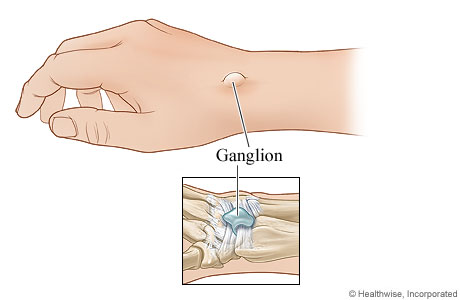Ganglion Cyst
A ganglion is a small sac (cyst) filled with clear, jellylike fluid that often appears as a bump on the hands and wrists, but it can also develop on feet, ankles, knees, or shoulders. Ganglions are not cancerous.
The cause of ganglions is not known, but it may be a reaction to an injury that causes the tendon sheath (which covers the tendon) or joint capsule (which protects the joint) to form extra fluid and balloon out.
A ganglion grows out of a joint, pushing up out of the joint tissue like a balloon. Most people with ganglions notice that the bumps appear suddenly. They may be as small as a small green pea or larger, are usually not painful, and may be movable. They may grow as activity increases, because more fluid collects in the sac. They may also shrink and may break open on their own.
Ganglions are not serious and may go away on their own. If a ganglion is not bothersome, treatment is usually not needed. If a ganglion is painful or unsightly or limits activity, it can be drained (aspirated) and possibly injected with a corticosteroid, although ganglions often come back after being drained. A ganglion can also be surgically removed.
Smashing a ganglion with a heavy object is not recommended because it usually does not work and may cause injury.
Symptoms
Dorsal Wrist Ganglion

Ganglions are small sacs (cysts) filled with clear, jellylike fluid. They often appear as bumps on the hands and wrists, but they can also develop on the feet, ankles, knees, or shoulders. A ganglion can grow out of a joint capsule, which surrounds and protects the joint, or out of a tendon sheath, which covers the tendon (the ropey fibers connecting muscle to bone). Most people with ganglions notice that the bumps appear suddenly.
What are the symptoms of ganglions?
Ganglions are usually painless bumps that don't cause other symptoms. But sometimes they're tender to the touch. The pain may get worse with activity or pressure. If the ganglion puts pressure on nearby nerves, you may have tingling in your fingers, hand, or forearm. Some ganglions can weaken your grip or affect joint motion.
Diagnosis
How are ganglions diagnosed?
A ganglion can usually be diagnosed based on how it looks and where it is. Your doctor will also feel the bump and shine a light alongside it. If the bump is a ganglion, the light usually shines through it.
You may need an X-ray if your doctor suspects arthritis or injury. Some of the fluid found in the ganglion may be removed and examined. In rare cases, an MRI or ultrasound may be done.
Treatment
How are ganglions treated?
Ganglions usually don't need treatment, and they often go away on their own. But treatment may be needed if the ganglion causes pain or other symptoms, limits what you can do, affects your bones or ligaments, or gets infected. You may also want treatment if you're bothered by how the bump looks.
Your doctor may treat a ganglion by:
- Giving you a wrist or finger splint to wear.
- Draining fluid from the bump with a needle (aspiration).
- Injecting hydrocortisone into the joint.
- Doing surgery to remove it.
With or without treatment, ganglions may come and go and may get bigger or smaller.
Copyrighted material adapted with permission from Healthwise, Incorporated. This information does not replace the advice of a doctor.
